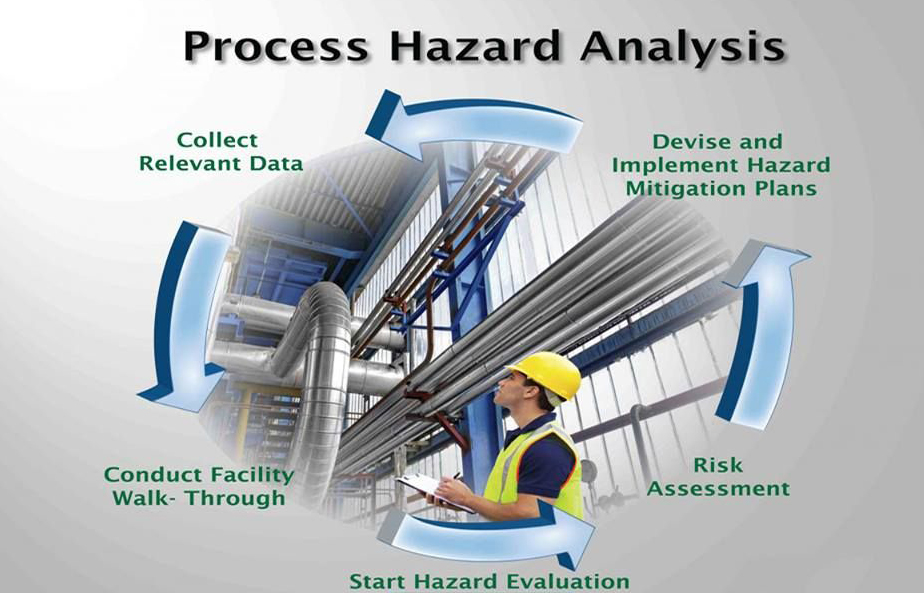Process Hazard Analysis
Process Hazard Analysis (PHA) is a thorough, orderly, and systematic approach for identifying, evaluating, and controlling the hazards of processes.
The process hazard analysis methodology selected must be appropriate to the complexity of the process and must identify, evaluate, and control the hazards involved in the process.

The process hazard analysis shall address the following:
- The hazards of the process
- The identification of any previous incident that had a likely potential for catastrophic consequences
- Engineering and administrative controls applicable to the hazards and their interrelationships
- Consequences of failure of engineering and administrative controls
- Stationary source siting
- Human factors and
- A qualitative evaluation of a range of the possible safety and health effects of failure of controls.
A Process Hazard Analysis (PHA) team includes process safety specialist, engineers, operators, supervisors and other workers who have knowledge of the standards, codes, specifications and regulations which apply to the process being studied.
KTT is an ASIAN representative of BELL ENERGY - a leading provider of PHA services and software tools. Bell Energy have performed PHA for large projects and operating facilities.
Services Offered
- Hazard and Operability Study (HAZOP)
- Hazard Identification Study (HAZID)
- Quantitative Risk Assessment (QRA).
- Bow-Tie Analysis
- What-If Analysis
1. Hazard and Operability Study (HAZOP)
HAZOP study is to carefully review a process or operation in a systematic manner to determine whether deviations from the design or operational intent can lead to undesirable consequences. This technique can be used for continuous or batch processes and can be adopted to evaluate written procedures. The HAZOP team lists potential causes and consequences of the deviation as well as existing safeguards protecting against the deviation. When the team determines that inadequate safeguards exist for a credible deviation, it usually recommends the action be taken to reduce the risk.
Objective of carrying out a HAZOP study:
- To check a design
- To decide whether and where to build
- To decide whether to buy a piece of equipment
- To obtain a list of questions to put to a supplier
- To check running instructions
- To improve the safety of existing facilities
2. Hazard Identification Study (HAZID)
HAZID (Hazard Identification) is a qualitative technique for the early identification of potential hazards and threats effecting people, the environment, assets or reputation. The major benefit of a HAZID study is to provide essential input to project development decisions. It is a means of identifying and describing HSE hazards and threats at the earliest practicable stage of a development or venture.
Objective of the study:
To identify the potential hazards and to reduce the probability and consequences of an incident in site that would have a detrimental impact to the personnel plant, properties and environment.
3. Quantitative Risk Assessment (QRA)
QRA (Quantitative Risk Analysis) is proven as a valuable management tool in assessing the overall safety performance of a Chemical Process Industry.
Objective of QRA:
- To identify, quantify and assess the risk from the facility from the storage and handling of chemical products
- To identify, quantify and assess the risk to nearby facilities / installations.
- To suggest recommendations in order to reduce the risk to human life, assets, environment and business interruptions to as low as reasonably practicable.
4. Bow-Tie Analysis
Bow tie analysis is a hazard analysis technique which is combination of fault tree analysis (FTA) and event tree analysis (ETA). Fault tree analysis (FTA) is identifying basic events that can lead to an accident event, where as Event tree analysis (ETA) is identifying the event sequences from initiating events to accident scenarios.
Benefits of Bow Tie Analysis:
- Highly effective for initial Process Hazard Analysis
- Ensures identification of high probability-high consequence events
- Combined application of a high-level fault/event trees
- Representation of the causes of a hazardous scenario event, likely outcomes, and the measures in place to prevent, mitigate, or control hazards
- Existing safeguards (barriers) identified and evaluated
- Typical cause scenarios identified and depicted on the pre-event side (left side) of the bow-tie diagram
- Credible consequences and scenario outcomes are depicted on the post-event side (right side) of the diagram
- Associated barrier safeguards included
5. What-If Analysis
The What-If Analysis technique is a brainstorming approach in which a group of experienced people familiar with the subject process ask questions or voice concerns about possible undesired events.
The purpose of a What-If Analysis is to identify hazards, hazardous situations, or specific event sequences that could produce undesirable consequences. An experienced group of people identifies possible abnormal situations, their consequences, and existing safeguards, and then suggests alternatives for risk reduction where obvious improvement opportunities are identified or where Safeguards are judged to be inadequate. The method can involve examination of possible deviations from the design, construction, modification, or operating intent. It requires a basic understanding of the process intention, along with the ability to mentally combine possible deviations from the design intent that could result in an incident. This is a powerful technique if the staff is experienced; otherwise, the results are likely to be incomplete
